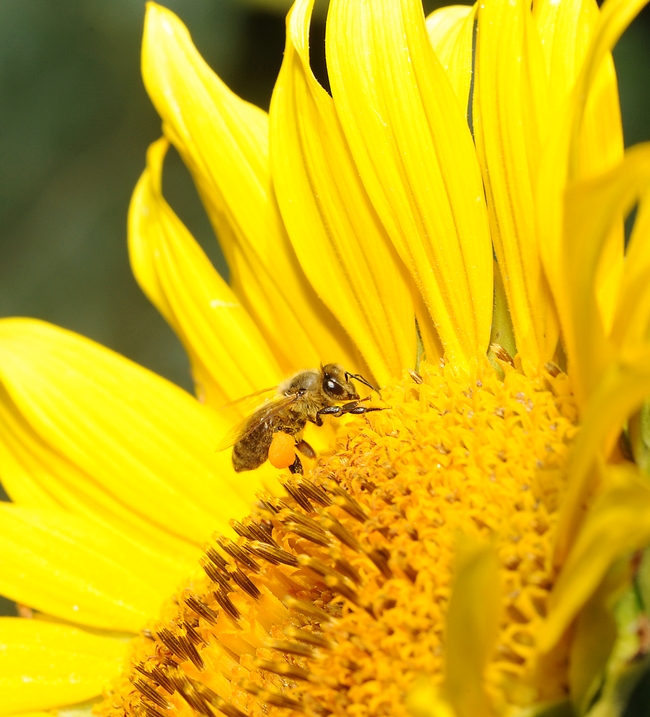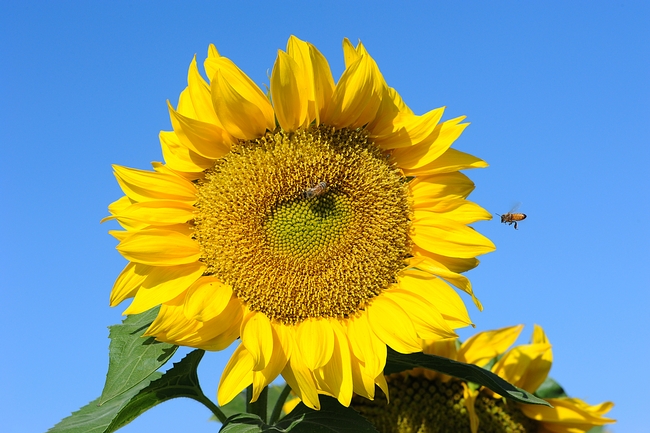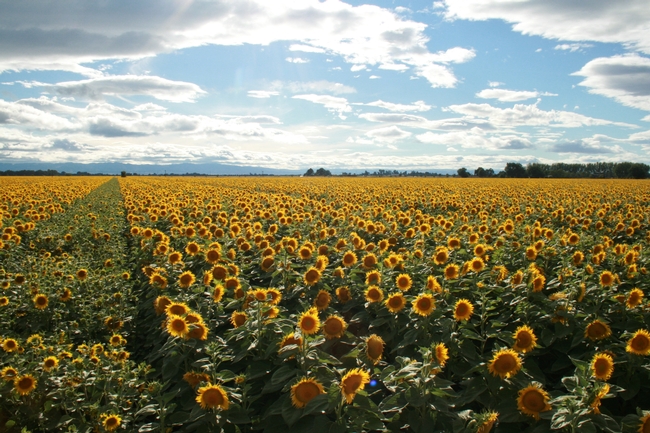Posts Tagged: sunflowers
Sunflower seeds are boosting California’s ag economy
Sunflower seeds are a healthy snack, a salad garnish, and a baseball dugout icon. But how much do you know about the state’s hybrid seed production that results in the global planting and growing of oil and confectionary-type sunflower seeds?
Do you know that the Sacramento Valley produces about 25 percent of the world’s hybrid planting sunflower seeds? We grow some 47,000 acres of this crop, valued at about $70 million (2012 County Crop Reports).
Even better news is that the hybrid sunflower seed production industry is growing, sparked by the demand for our high quality seed and the increased interest in sunflower oil worldwide. In 2007, for example, the value of California’s sunflower seed crop totaled $22 million on 27,000 acres. Fast forward to today and we see a 70 percent increase in acreage and more than a three-fold increase in value. Additionally, the industry reports millions of dollars in seed sales to markets around the world including the Midwestern states as well as the four largest producers of sunflower oil: Ukraine, Russia, European Union, and Argentina.
The sunflower (Helianthus annuus) is native to North America; the Native American Indians prized it as an important, high-energy food source. Indeed, sunflower oil is a healthy choice; it is light in taste, supplies more vitamin E than any other vegetable oil, and delivers low levels of saturated fat. Sunflower oil is also stable at high cooking temperatures, rendering it favorable to the food processing industry.
Production of hybrid sunflower seeds involves planting male and female (male sterile) lines in the same fields, usually alternating with six rows of females and two rows of males. Males generally possess multiple flowers on a stock, compared to the single composite female flower. Honey bees, usually two colonies per acre, move the pollen from the male to female lines. Native solitary bees (especially sunflower bees) are also important in sunflower seed production, not only because of their pollination but because their presence increases honey bee activity, causing greater dispersement between male and female lines.
After pollination, when the seeds are set, growers remove the male rows to prevent contamination with female rows. After the sunflower stocks naturally dry down, the hybrid planting seed is harvested with yields averaging 1,400 pounds per acre and 40-45 percent percent oil content, depending on the variety.
Compared to open pollinated varieties, hybrid planting seed from controlled crosses of male and female lines result in higher yields and oil content. The plants also display better disease resistance, a high degree of self-compatibility (reducing the need for bee cross-pollination), and more uniformity in height and moisture content at maturity, which facilitates harvest.
It’s crucial to maintain field isolation between different hybrid sunflower varieties so that the seed produced remains pure to the desired cross. As a result, growers plant different sunflower seed varieties at least 1-1/4 miles apart or they separate fields in time so that they bloom at different times in the season, thus preventing pollen drift. volunteer sunflowers from the previous year, wild sunflowers, and sunflower varieties blooming in backyard gardens pose risks to hybrid sunflower seed production. Roguing prior to bloom is important when nearby production fields are blooming.
Do you know that sunflower seed production has few pest or disease problems? Sunflower head moth, a native caterpillar pest, can attack the seed heads as well as occasional flocks of birds (starlings, blackbirds, and finches) triggering yield and quality losses.
As the result of industry and research efforts, along with our near perfect weather for seed production with hot, dry summers and cool nights, the Sacramento Valley is known throughout the world as a premier location for sunflower breeding, variety development, and seed production.
In the summertime, the brilliant golden colors turn fields in the Sacramento Valley into Vincent Van Gogh-like paintings. Sunflowers are also fun to watch because in the bud stage they track the movement of the sun across the horizon. Once the flower opens it faces east toward the morning sun, which may help prevent the sun-scalding of seeds.
So, whether you like to cook with sunflower oil, snack on sunflower seeds, use them as a salad garnish, or watch your favorite baseball players crack them between innings, sunflowers pack a major economic agricultural wallop that begins right here in the Sacramento Valley. Who knew? Now you do.
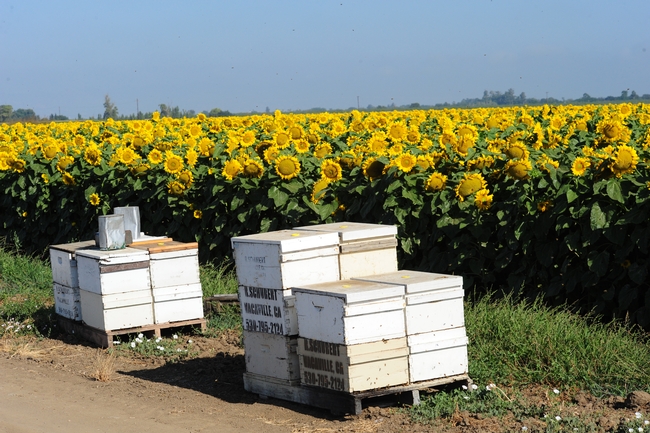
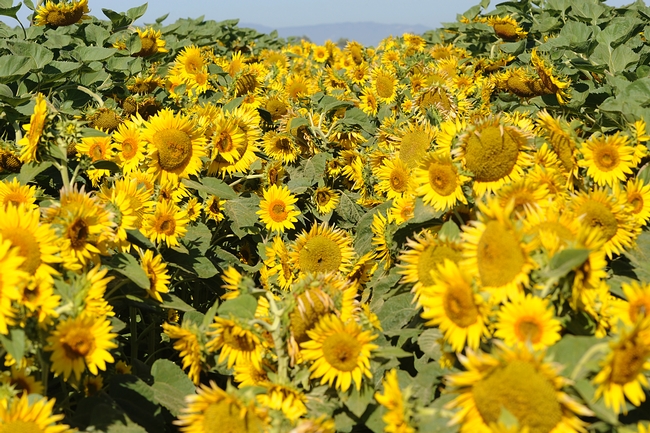
The State Fair: Bees, Butterflies and Sunflowers
Bees, butterflies and sunflowers at the California State Fair? Yes. The state fair, which opened July 12 and ends July 28, is a good place to see a...
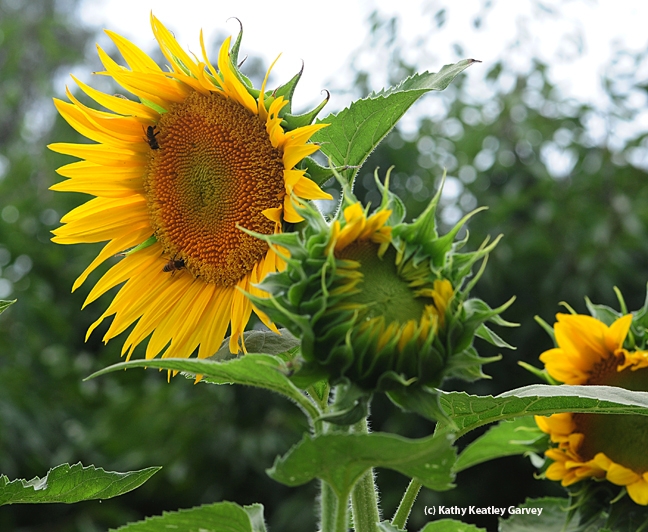
Sunflowers grow as high as an elephant's eye at the California State Fair. (Photo by Kathy Keatley Garvey)
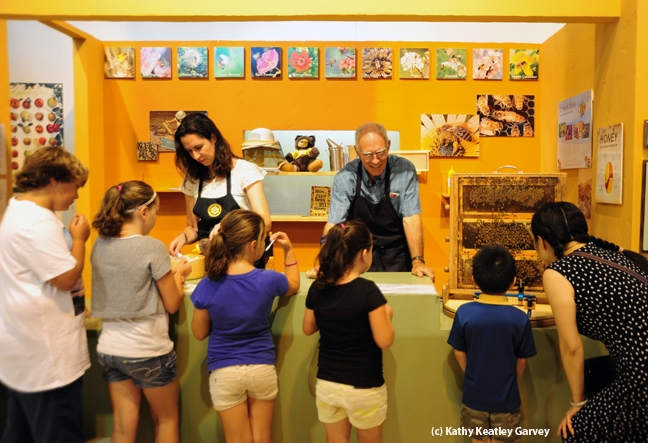
Beekeeper Doug Houck of the Sacramento Area Beekeepers' Association and his daugher, Rebekah Houck, at the beekeepers' booth in the Expo Center. (Photo by Kathy Keatley Garvey)
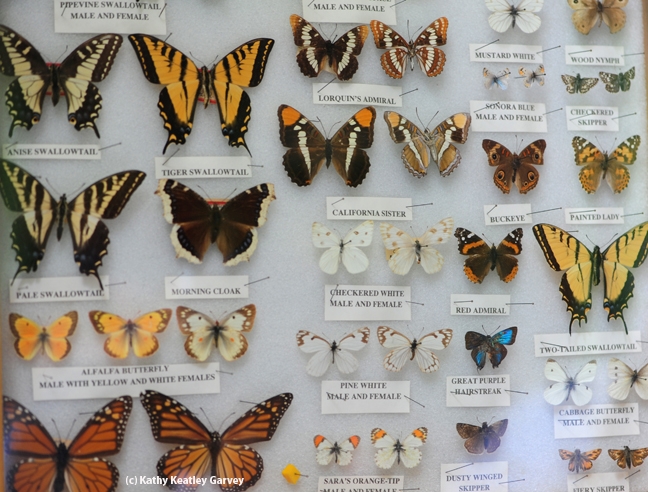
Butterfly specimens in the Insect Pavilion. (Photo by Kathy Keatley Garvey)
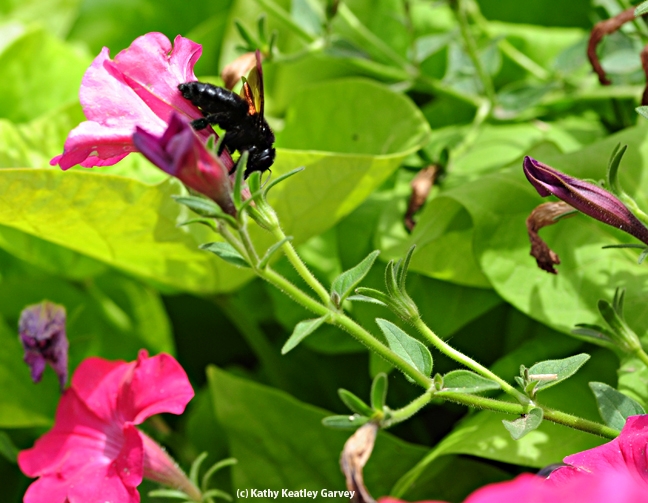
A female Valley carpenter bee working a petunia. (Photo by Kathy Keatley Garvey)
Stunting Sunflower Growth
I know this post will ultimately make a lot of you cringe at what I do. But just as art is in the eye of the beholder, the joy of gardening, whether done the right way or the wrong way, is in the hands of the individual. And as individuals, we often do things differently.
There are proper ways to stunt or control plant height and growth practiced by greenhouse growers. These methods employ either use of either a chemical plant growth retardant (http://www.extension.purdue.edu/extmedia/HO/HO-248-W.pdf), or environmental or cultural control methods (http://extension.umass.edu/floriculture/fact-sheets/controlling-plant-height-without-chemicals). But what I’m writing about below is not the proper way to do things, but it’s what I do to suit my needs. So here goes.
For years I grew rows of Mammoth Sunflowers (Helianthus annuus) in my backyard simply because the flowers are so cheerful. I love the structure of a sunflower, and don’t really care about the size of the flower or the seeds. But a few years ago when my neighbor stopped plowing my backyard for me because he stopped farming, I reached the point where I was tired of digging up the enormous sunflower plants and chopping up the thick ten to twelve foot stalks at the end of each season. I decided it wasn’t worth the physical effort to grow them in my backyard anymore.
So the last couple years I’ve been planting sunflower seeds in impromptu planters. No, not the seeds for dwarf sunflowers, but the seeds for full sized sunflowers. Why don’t I just plant the seeds for dwarf sunflowers? Two simple reasons: cost and availability. I can always buy a packet of sunflower seeds for a quarter or less at my local dollar store. The dwarf sunflower seeds, which produce beautiful lush plants and flowers, are more expensive and I usually have to hunt for the seeds at local retailers or end up purchasing them through the mail.
By planting the seeds for full sized sunflowers in planters, I intentionally stunt their growth so that I end up with miniature, albeit not the healthiest looking plants. But the plants take up little space and the baby sunflowers still make me smile. And since earlier this year a friend sent me some steaks that the company shipped in styrofoam coolers, I decided to recycle the bottoms of the coolers and turn them into planters. So I punched holes in the bottom of them, added some soil, and the photos below show my stunted sunflower plants which are just starting to bloom.
If you want to grow sunflowers in planters, you should purchase dwarf sunflower seeds suited for container gardening. The reason I shared with you what I do is to illustrate you should never be afraid to experiment in your gardening, be it trying a new method, or growing something you’ve never grown before. Adapt your gardening practices to meet your own needs. And regardless of whether something turns out right or wrong, gardening should always bring you joy. So have fun in your garden!
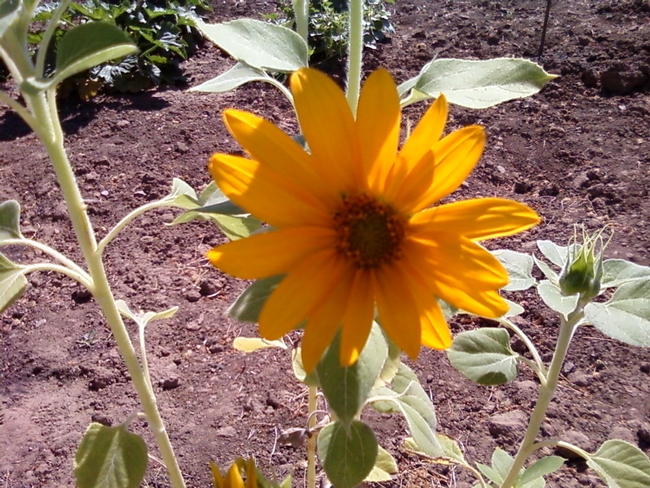
Stunted mammoth sunflower. (photos by Kathy Low)
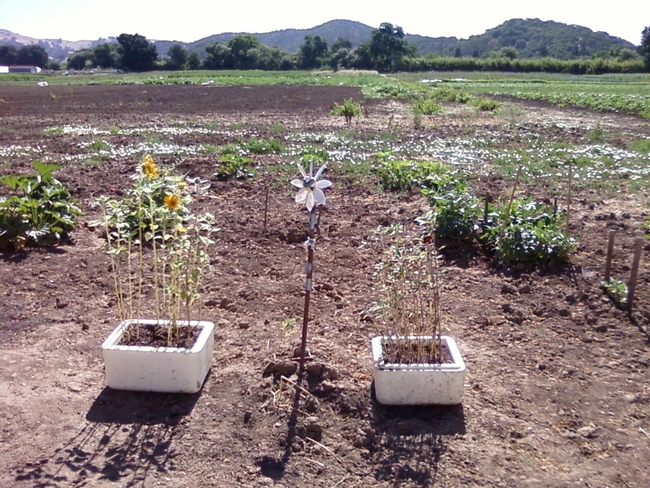
Sunflowers planted in impromptu planters.
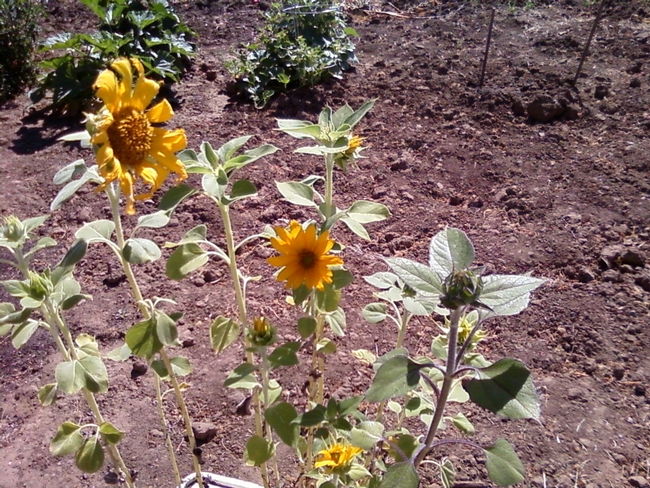
Sunflowers starting to bloom.
Sunny-Side Up
You can tell it's summer along Yolo County roads by the acres and acres of sunflower fields. Looking like real-life Van Gogh paintings (Van Gogh...
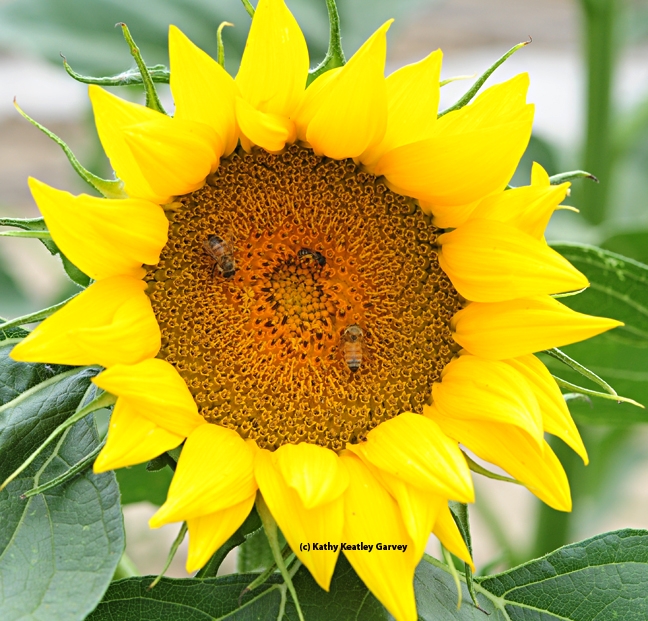
Honey bees and a sunflower bee forage on a sunflower head. (Photo by Kathy Keatley Garvey)
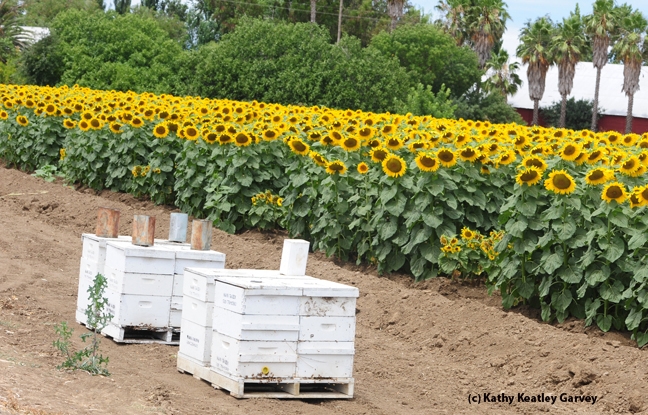
Bee boxes line a sunflower field. (Photo by Kathy Keatley Garvey)
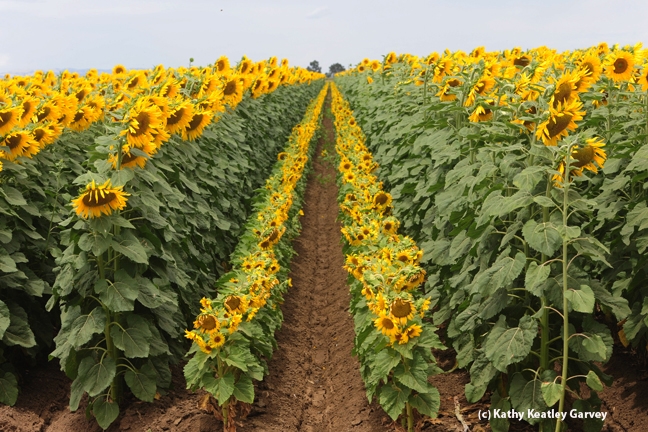
A spectacular sunflower field. (Photo by Kathy Keatley Garvey)
How NOT to Grow Giant Sunflowers
A few years ago, we grew a mammoth sunflower that my son has talked about ever since. We had planted it in our raised vegetable bed so it had good sun, good soil, and a good water supply. Unfortunately, it wasn’t so good for the vegetables that struggled to compete with it!
We have tried to grow giant sunflowers every year since in other areas of the yard that didn’t require sacrificing a zucchini plant or a tomato crop. But perhaps due to the clay soil, more sporadic irrigation, or hungry birds or squirrels, we couldn’t even get the seeds to germinate.
So this year, I gave up a corner of my raised vegetable bed to growing a giant sunflower again for my son. The seeds germinated quickly and the seedlings happily grew . . . and then we went on vacation. When we returned, the seedlings were so big that I was reluctant to thin them for fear of disturbing the roots of their siblings. (That, and I’m a bit too soft-hearted to thin seedlings like I know I should.) Giant sunflowers should be space 20-24” apart. If they are planted too closely, the seed head will be smaller.
Ultimately, instead of a giant sunflower, we have ended up with a crop of 5 very tall sunflowers with good-sized—but definitely not giant—seed heads. Being contrary flowers, they prefer to face our sunnier neighbor’s yard than our own. We didn’t get the mammoth sunflower that we were hoping for, but I have to admit, the cheery faces of the sunflowers that we do have more than make up for it. Plus, I know my finches will be happy when the seeds ripen! It was definitely worth worth skipping a few zucchini this year.
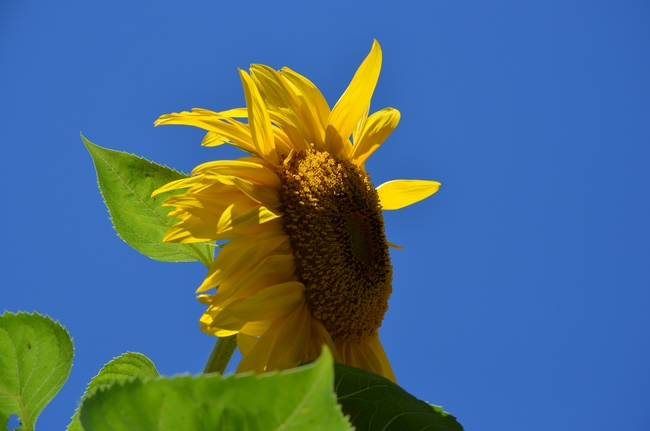
Giant sunflower. (photo by Erin Mahaney)


